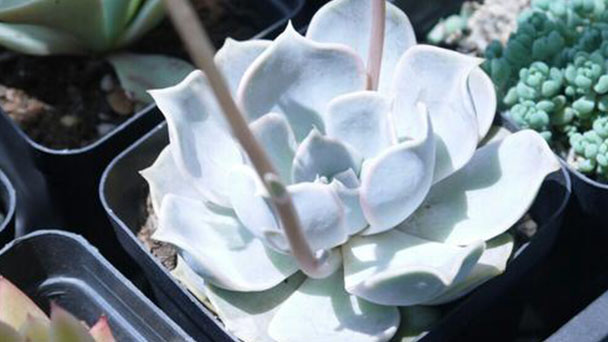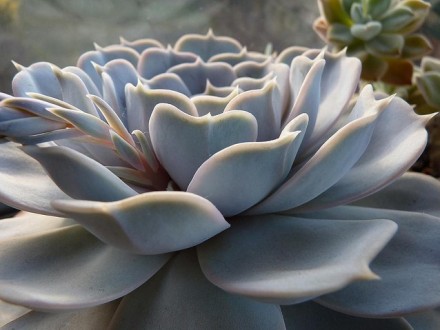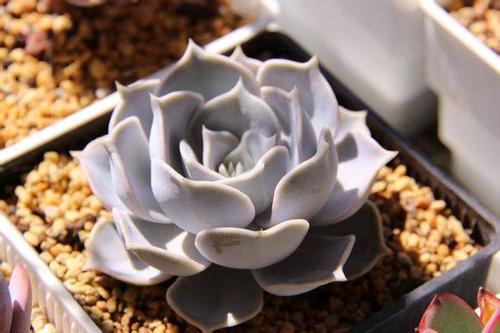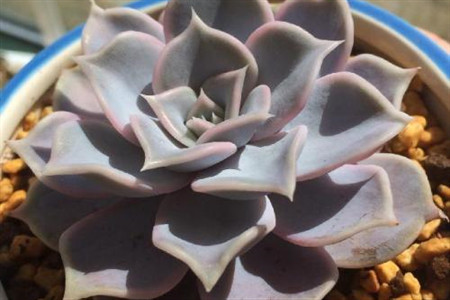Echeveria Lilacina (Ghost Echeveria) Profile - Grow and Care Guide
Written by Maggie
Nov 13 2021

Echeveria Lilacina (Ghost Echeveria) is a succulent plant of the genus Echeveria, native to Mexico. The plant is 11 to 17 cm long. Echeveria Lilacina is pale pink all year round, and its leaves are sharp, giving a sharp impression. The leaf blade is fleshy, light pink or pinkish purple, tip small tip, apex of leaf margin bending, central concave. Water is wet as well as dry. Because the leaves are with powder, so when watering we should avoid leaf contact with water, so as not to affect the appearance.
Echeveria Lilacina picture

Echeveria Lilacina Quick Info
| Botanical/Scientific Name | Echeveria Lilacina |
| Common Name | Ghost Echeveria |
| When to Grow/Bloom/Harvest | Grow in the spring |
| Uses | Removing toxins from the air |
| Origin | Nuevo Leon in the northern part of Mexico, Central America |
| Light Care | Full sun or very light partial shade. |
| Soil Care | Well-draining |
| Temperature Care | Betweem 65 and 80°F (18-27°C) |
| Humidity Care | 20 and 40% |
| Watering | Water when the soil is nearly dry |
| Pruning Care | Requires minimal pruning |
| Fertilizer Care | Water-soluble liquid fertilizer with a low to medium nitrogen content |
| Propagation | Cuttings |
| Toxic | Non-Toxic |
| Flower Color | Pale pink or coral-colored |
Morphological features of Echeveria Lilacina
Stems
The length of Echeveria Lilacina is less than 5 cm, the diameter is about 1.5 cm, no plant is divided under the natural growth condition.
Indus
11-17 cm in diameter.
Leaf
Rosettes of echeveria lilacina are densely arranged, obovate to spatulate, apex obtuse, short apiculate, 5 -- 6 cm long, 2.5 -- 3.7 cm at widest, 1 -- 1.2 cm at base, skin dark brown green, mauve to pale pink waxy cream powder, margin transparent.
Inflorescence
Each inflorescence of Echeveria Lilacina usually has only 1 cincinnati, sometimes 2.Early apex curved inward and late erect.28-36 cm in length, 3-5 mm in diameter.Bracts 14-26, 8-18 mm long, 4-6 mm wide.Pedicels are pendulous, erect when seeded, 9 -- 27 mm long, ± 1 mm in diameter, pink.
Flowers
Bracts of Echeveria Lilacina are appressed, apex upturned, 1.5-7 mm long, 1-4 mm wide, corolla urceolate, 6-7.5 mm in diameter. Petals str triangular to lanceolate, acute, 13-14 mm long, ca. 4 mm wide, coral-pink, apex sharply curved outward. The plant height is 5-6 cm, the plant width is 10-25 cm, the leaves are oval, the tip of the leaf is pointed, the middle of the leaf is inward concave, the edge of the leaf is pink and pointed.

The growth environment of Echeveria Lilacina
During the growing period of Echeveria Lilacina (spring and autumn), the soil in the basin was dry and wet, and could not be watered to the leaves and the center. The soil in the basin could be slightly wet in winter.Special attention should be paid to risk control water in summer.
Distribution range of Echeveria Lilacina
The Echeveria Lilacina is found in the wild near The Rayones, Nuevo Leon, Mexico.

Echeveria Lilacina Care in Detail
Echeveria Lilacina Watering
Spring and autumn are the peak growth seasons of Echeveria Lilacina. If we find that the soil is dry, we can pour water through the edge of the flowerpot and slowly penetrate until water flows out from the bottom. Be careful not to let water drop to the center of Echeveria Lilacina leaves, otherwise the leaves are easy to rot. The soil is slightly dry in summer and winter, and the watering can't be thorough. In addition, whether it's Echeveria Lilacina just bought or newly launched, you can't rush to pour it. Put the basin in a ventilated place first, and then water Echeveria Lilacina a a week later.
Echeveria Lilacina Soil
The soil we selected for Echeveria Lilacina propagation requires air permeability and good drainage. Generally, it is better to mix soil, such as peat and cinder, which are configured according to a certain proportion.
Echeveria Lilacina Light
Echeveria Lilacina has low requirements for light and maintains sufficient light. Generally, except in summer, it can be taken all day. In summer, due to high temperature and strong light, it is necessary to provide appropriate shade and avoid direct sunlight. In winter, we should keep Echeveria Lilacina in a sunny place indoors and receive more sunlight. Because Echeveria Lilacina will affect viewing if there is insufficient light.
Echeveria Lilacina Temperature
Echeveria Lilacina likes a warm, dry and sunny environment. It is resistant to drought, water and humidity. The dormancy period is not obvious. The suitable temperature for growth is 15-25 ° C, and the temperature in winter is not lower than 0 ° C. properly maintained Echeveria Lilacina leaves are wrapped layer by layer. If it is a pink blue lotus, the edge of the leaf tip is bent and twisted and presents pink, which is very beautiful.
Echeveria Lilacina Humidity
Echeveria Lilacina needs a humid environment. You obviously don't have enough water supply. There is not enough water, so you can only consume leaves. If Echeveria Lilacina lacks the necessary water and nutrition for a long time, of course, the situation is getting worse and worse. Echeveria Lilacina leaves soften when there is too little water. In addition to water control in summer, if it is not lower than 10 ℃ in winter, there is no need to deliberately control water. You can ensure that the soil surface of Echeveria Lilacina is dry and water it every two days after drying.
Echeveria Lilacina Fertilizer
When Echeveria Lilacina grows vigorously, it needs to be watered and fertilized in time. How can Echeveria Lilacina be best fed? Although it has strong drought tolerance, it can still be watered every other week. In winter, it is good to water every half a month. Generally, it is not necessary to apply fertilizer to Echeveria Lilacina. If nitrogen and phosphorus fertilizer are applied every other month during the growth period, Then it can make Echeveria Lilacina burst.
Echeveria Lilacina Pruning
If Echeveria Lilacina grows too fast or its body size has exceeded the limit of the flower pot, you should also pay attention to the pruning of Echeveria Lilacina, and the pruned part can be planted in the pot to form a new Echeveria Lilacina.
Echeveria Lilacina Repotting
Echeveria Lilacina doesn't have high requirements for soil, but the most important thing for potting is soil. First, prepare some nutrient-rich and fertile peat soil, and then mix with some coarse-grained vermiculite and river sand. In this way, the soil will be especially breathable and drained after mixing, which is very good for Echeveria Lilacina's roots, Before we replace Echeveria Lilacina, we'd better sprinkle some organic base fertilizer on the basin bottom to make the soil fertility last longer. Basically, we don't need to replace in 1 or 2 years. After planting in the basin, we can spread some white perlite on the surface of the soil, which not only makes the soil more breathable but also sets off each other's colors, which will highlight the beauty of Echeveria Lilacina.
Echeveria Lilacina Pest & Disease Control
Starscream:
The larvae of red spider mostly feed on the juice of the young stems and leaves of Echeveria Lilacina, and the damaged stems and leaves will appear yellowish-brown spots or withered and fall off, which can not fade. If this hazard occurs, in addition to strengthening ventilation and cooling measures, dicofol solution can also be used for spraying to kill insects.
Scale insects:
Scale insects mainly suck the stem and leaf juice of Echeveria Lilacina, resulting in poor plant growth and death in serious cases; When pests occur, in addition to using a brush to drive them away, we can also spray them with the vegetarian killing solution.
Aphid:
If there are too many aphids on Echeveria Lilacina, it will cause plant growth weakness, and the secretion of aphids will attract ants; When aphids are first found, drug control should be carried out. We can spray 80% DDVP EC.
Echeveria Lilacina Propagation from Leaf Cutting
For Echeveria Lilacina propagation from cutting, we can choose robust leaves and put them on clean tidal soil. The light intensity can not be too strong, and scattered light can grow small buds within one week and two weeks. The soil selected for Echeveria Lilacina propagation requires air permeability and good drainage. Generally, it is better to mix soil, such as peat, cinder and so on, According to a certain proportion, it is difficult to spend summer and winter with a large number of succulent plants, and Echeveria Lilacina is no exception. In summer, we need to pay attention to shading and maintain the ventilation of the environment, and reduce watering or do not water.
For the leaves of Echeveria Lilacina propagation from leaf cutting, we must choose healthy, full, disease-free and vigorous leaves. After selecting the leaves, we can cut them off with a knife. In the process of cutting the leaves, we must not hurt the plants of Echeveria Lilacina.
At the same time, we should put the cut Echeveria Lilacina in a cool place and wait for the wound of the leaves to dry and heal.
The soil of Echeveria Lilacina propagation from leaf cutting shall be kept slightly wet, and then the leaves of Echeveria Lilacina shall be placed on the soil of the flower pot, and the tail of the leaves shall be in contact with the soil as much as possible, which is conducive to the rooting of the leaves. Generally, after Echeveria Lilacina propagation from leaf-cutting, we can place the flower pot in a ventilated and cool place, It won't take many days to take root and sprout.
Echeveria Lilacina Benefits
Echeveria Lilacina has ornamental value. Echeveria Lilacina is a succulent plant of the genus philoxeroides, with layers of whorled leaves arranged closely, just like exquisite lotus petals, with exquisite and elegant shape. The leaf blade is oval, the leaf tip is round, the curve is smooth, the leaf blade is concave inward, with light pink, and the top is naturally curved. The leaves of Echeveria Lilacina sometimes appear pink blue or pink, which is very beautiful. Echeveria Lilacina looks like a handmade work of art with high ornamental value. Potted plants decorate the home and decorate the indoor environment.
Echeveria Lilacina has the function of purification. The potted plants of Echeveria Lilacina are placed next to the TV or computer to absorb radiation. This is a function of Echeveria Lilacina. If you like meat, you can try to breed Echeveria Lilacina, and you will be pleasantly surprised.
Latest Updated
- Benefits of Bugleweed - 7 Science-backed Health Benefits
- Bugleweed Dangers & Side Effects - Is It Poisonous?
- How to Plant Evergreen Trees - What You Should Know
- When to Plant Evergreens - Grow Guide for Evergreen Trees
- 12 Wonderful Evergreen Shrubs for Your Garden
- 12 Popular Evergreen Plants with Pictures for Beginners
- When And How To Prune A Lilac Bush Like a Pro
- How to Grow & Care for Lilac Vine (Hardenbergia Violacea)
- Japanese Lilac Tree (Syringa Reticulata) Care & Propagation Guide
- Shumard Oak Pros and Cons - What to Know
Popular Articles
- Winter maintenance of Antirrhinum Majus
- How to Grow Terminalia Mantaly Tree
- How to Grow and Care for Crossostephium Chinense
- How to grow Antirrhinum Majus in spring
- Peristeria Elata (Dove Orchid) Profile: Info & Care Guide
- Underwatered Snake Plant (Sansevieria Trifasciata) - Signs And How To Fix
- How to Care for Brazilian Jasmine Plant (Mandevilla Sanderi)
- How to Grow & Care for Graptopetalum Purple Delight in Summer
- Rosa Chinensis (China Rose): Plant Growing & Care Tips
- How to Care for Baby Sun Rose (Aptenia Cordifolia)